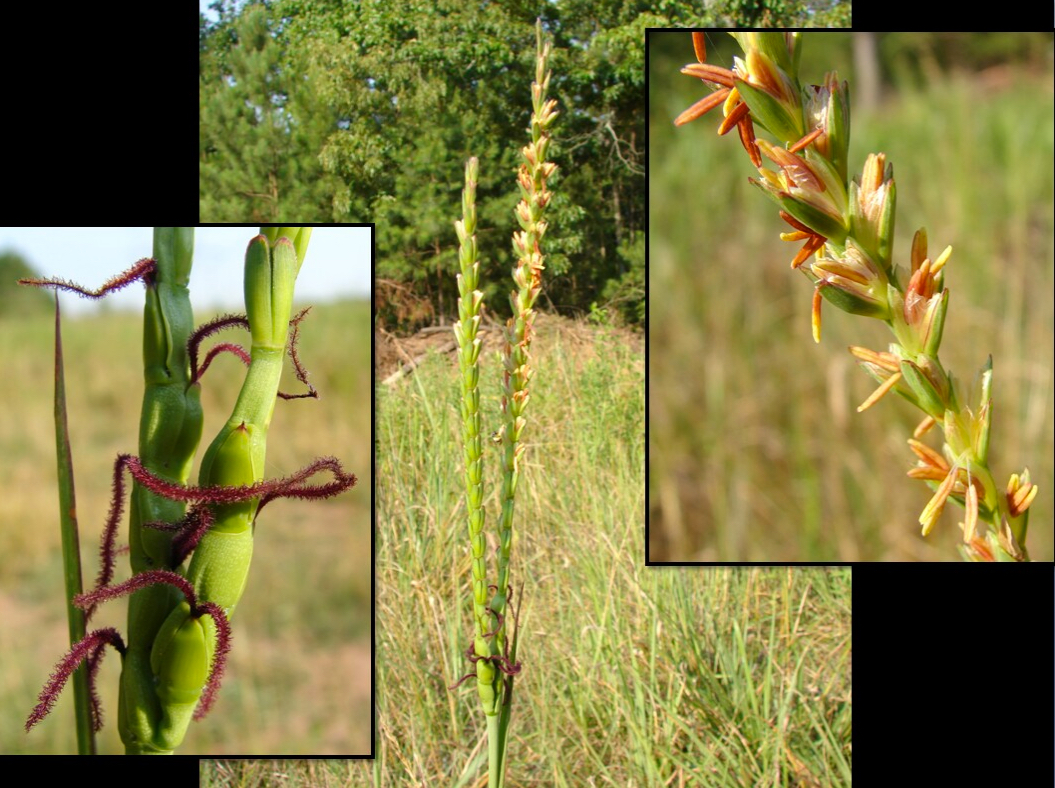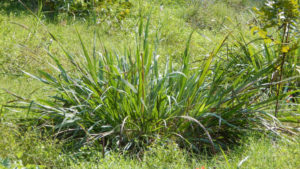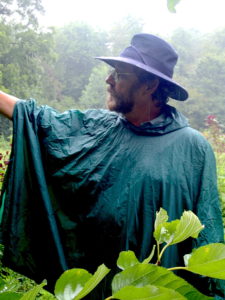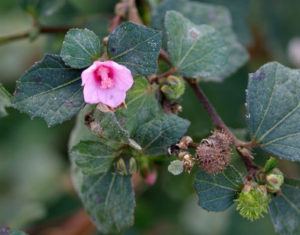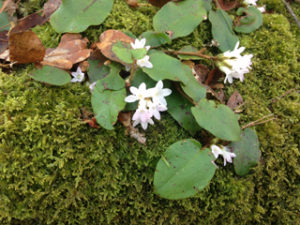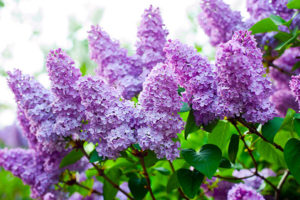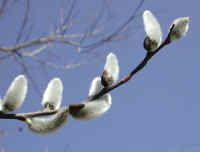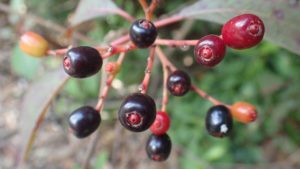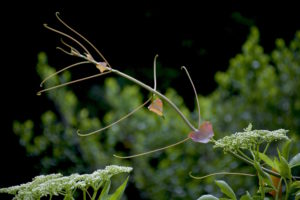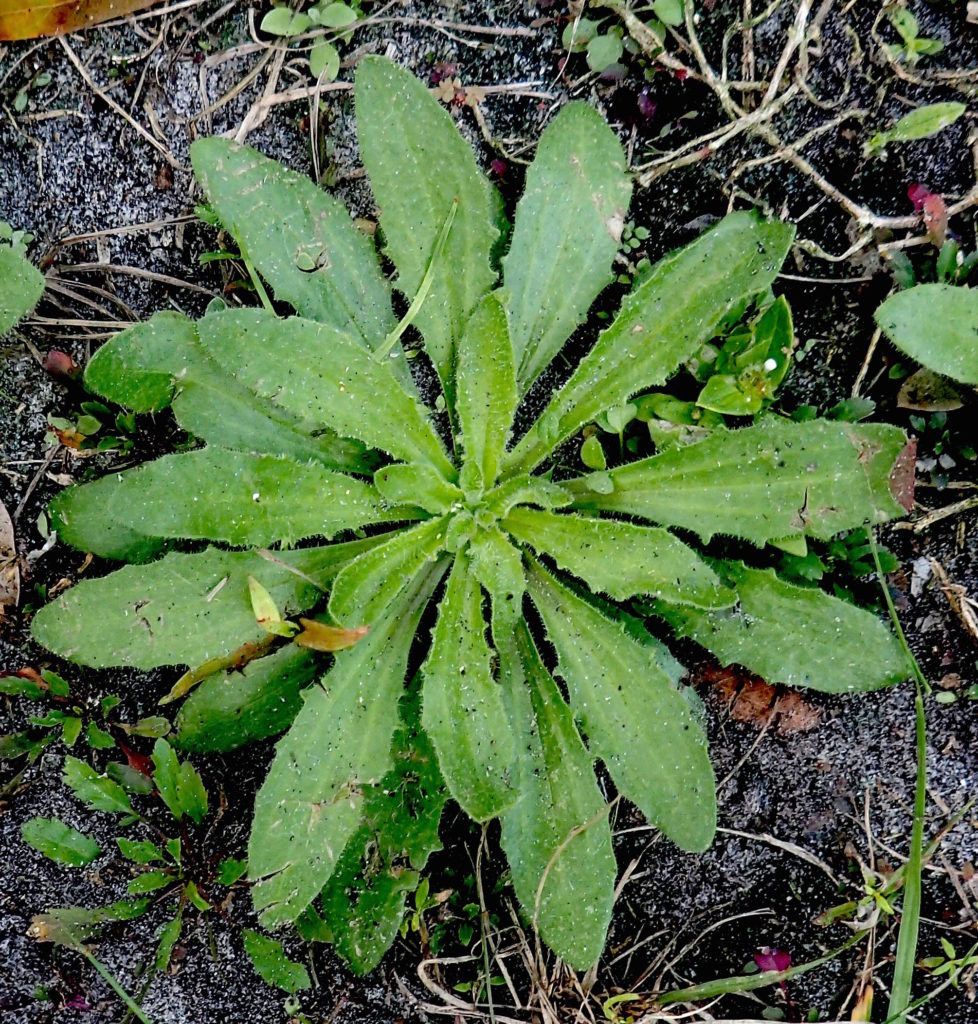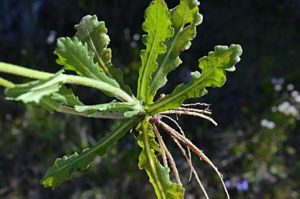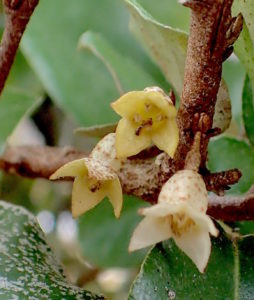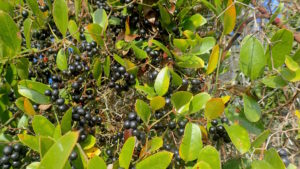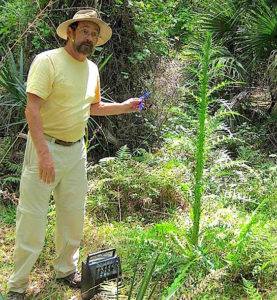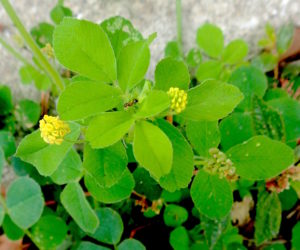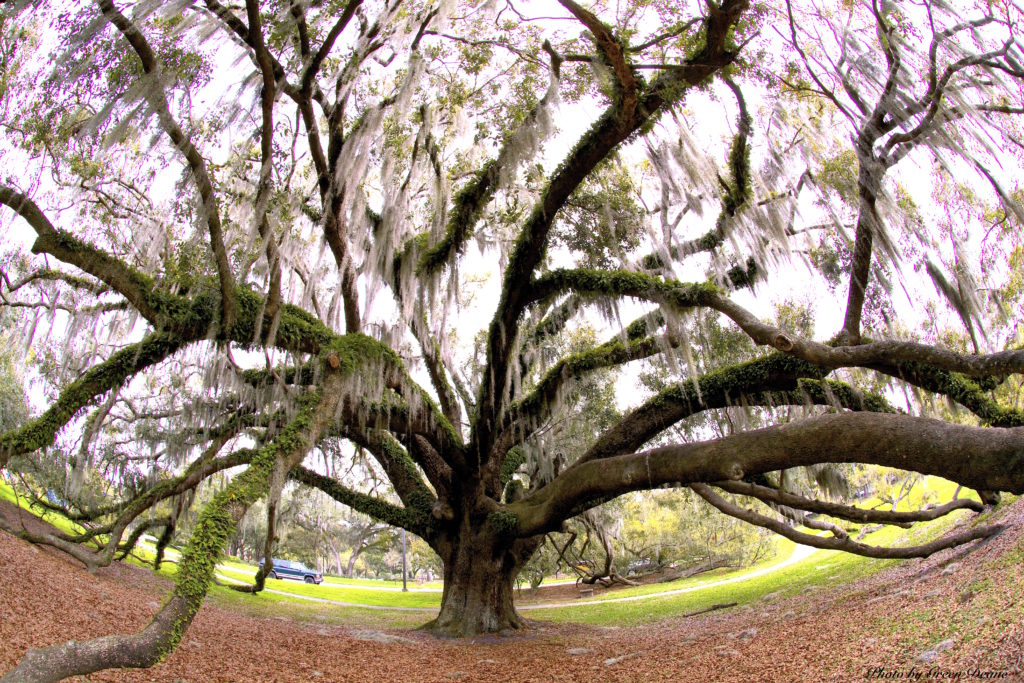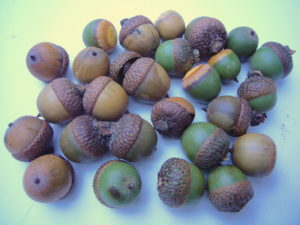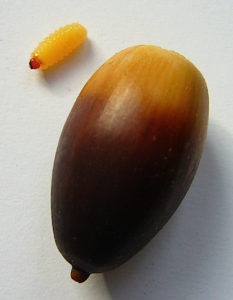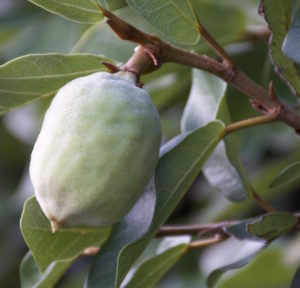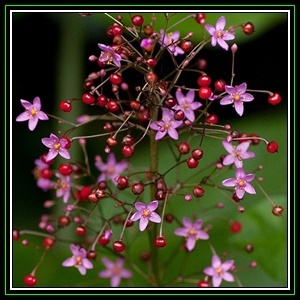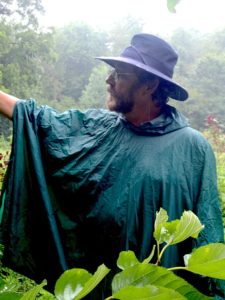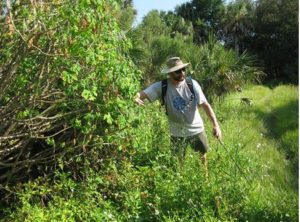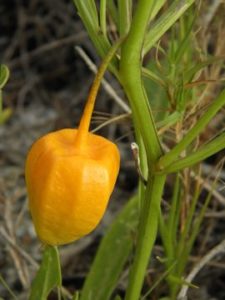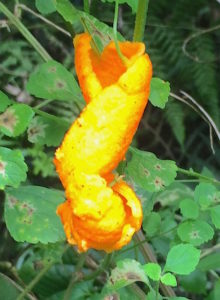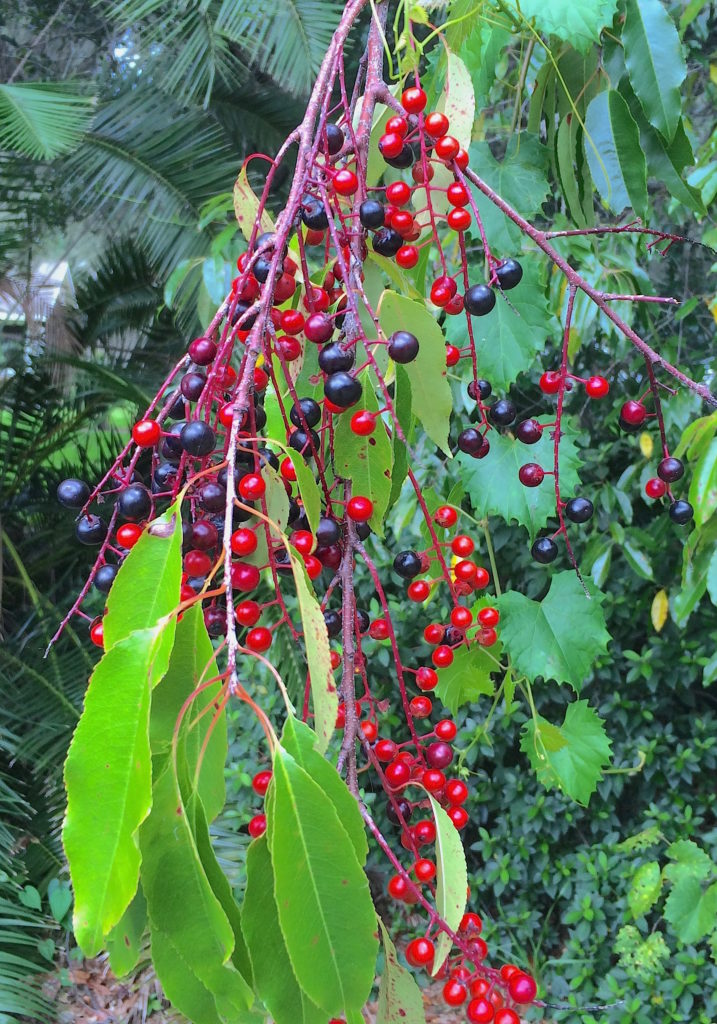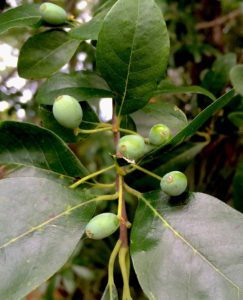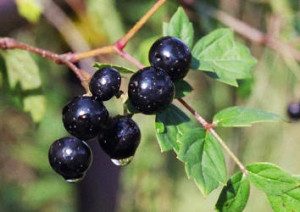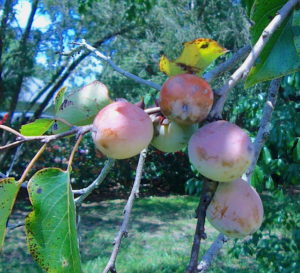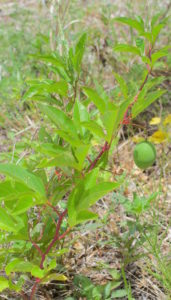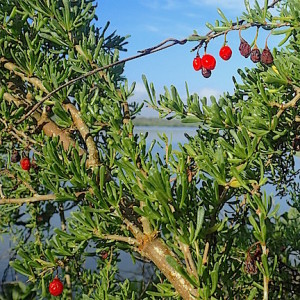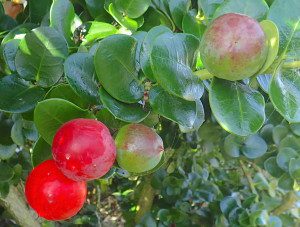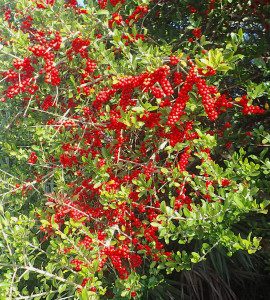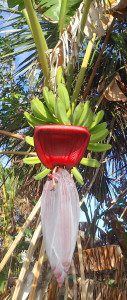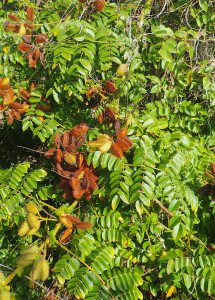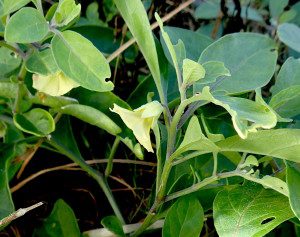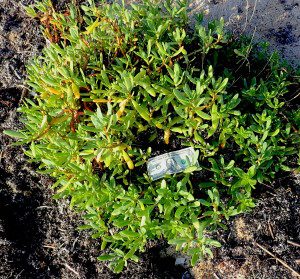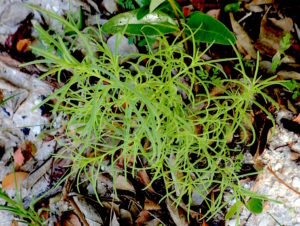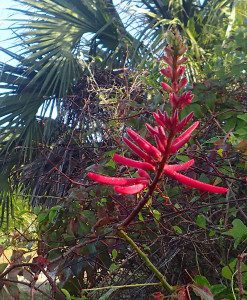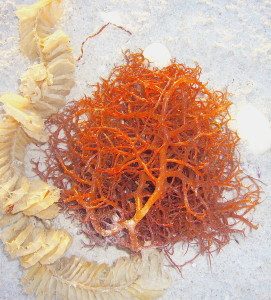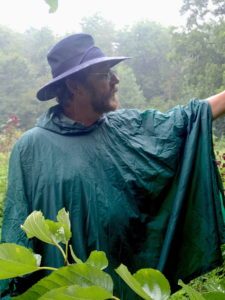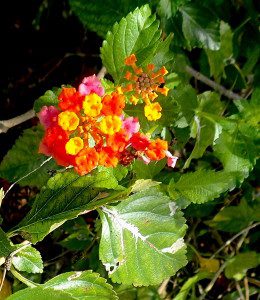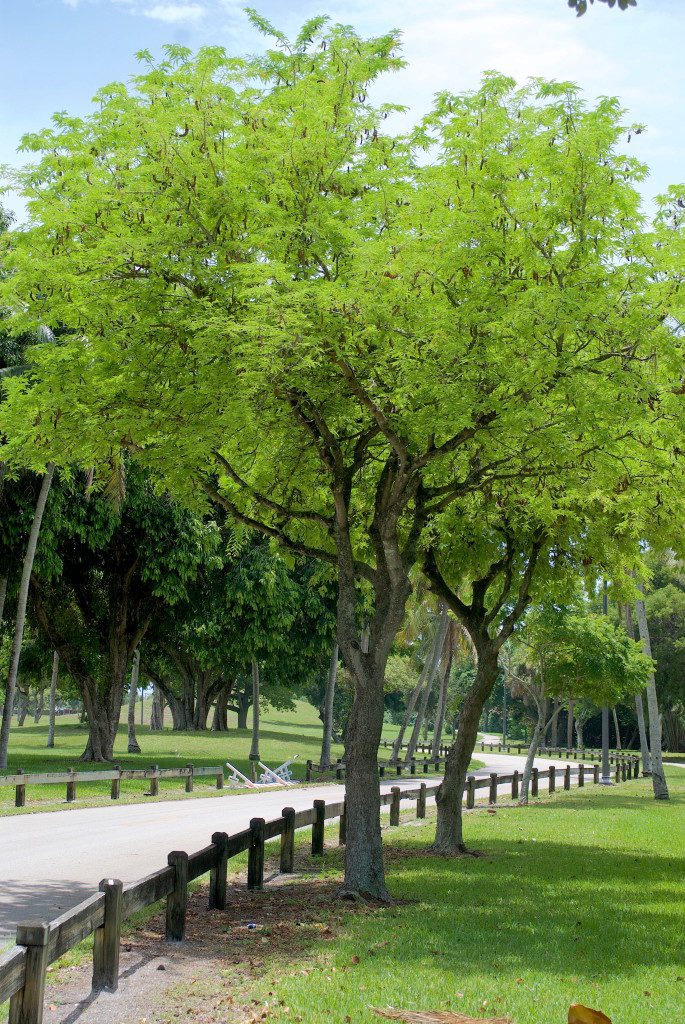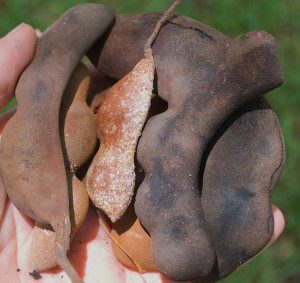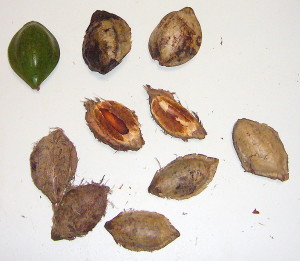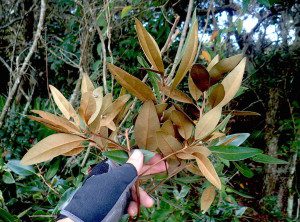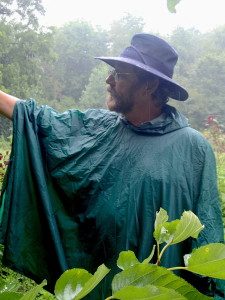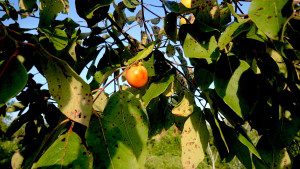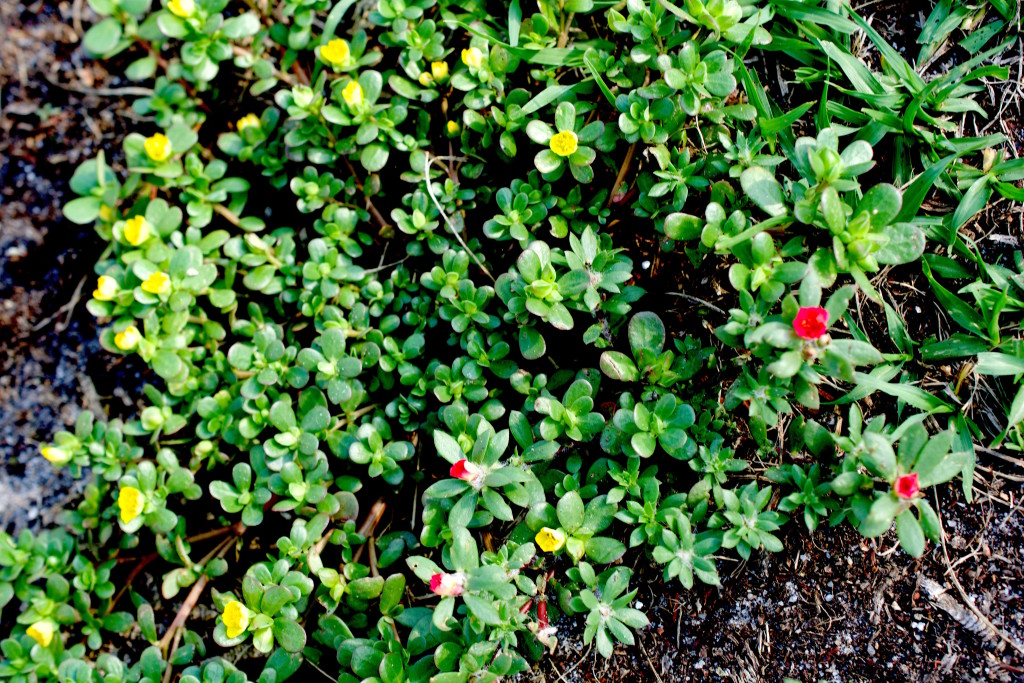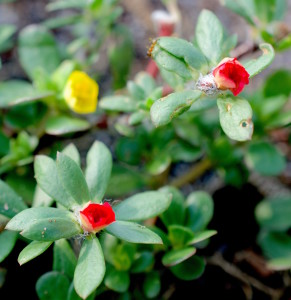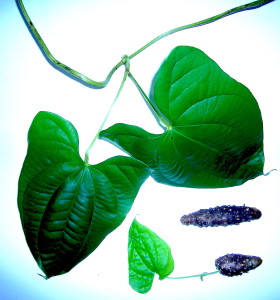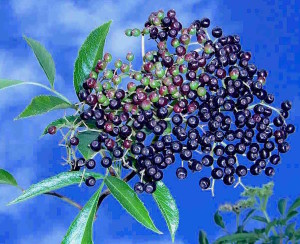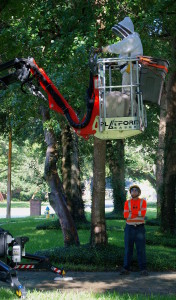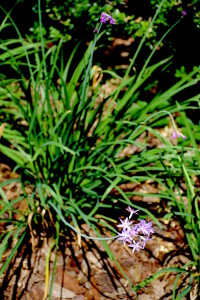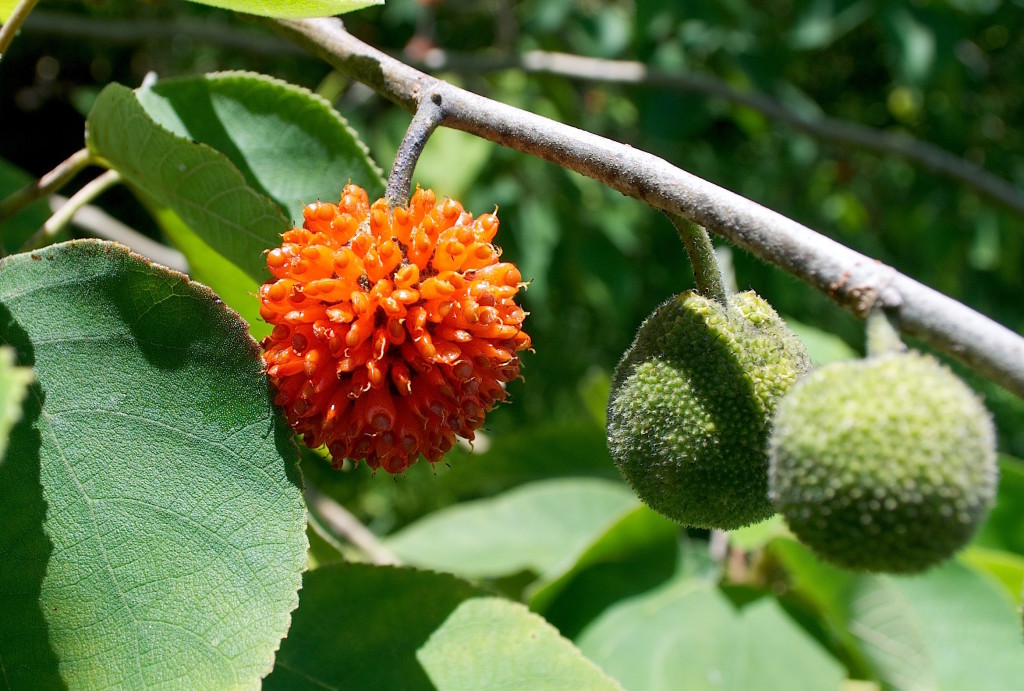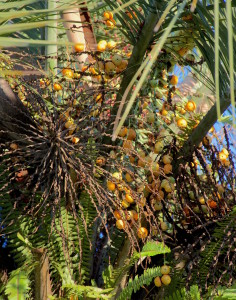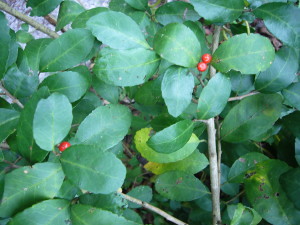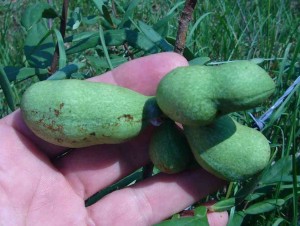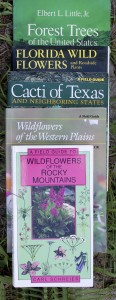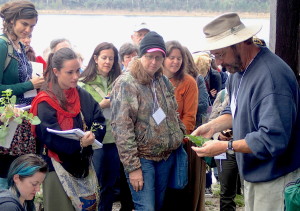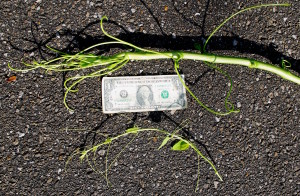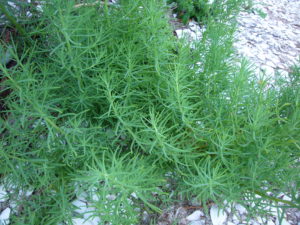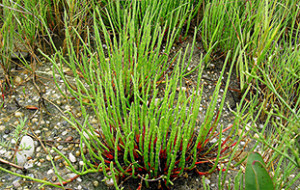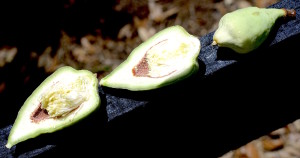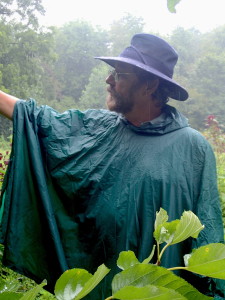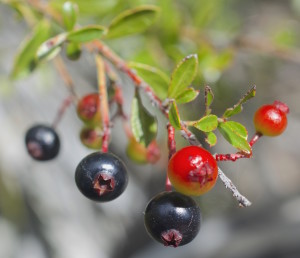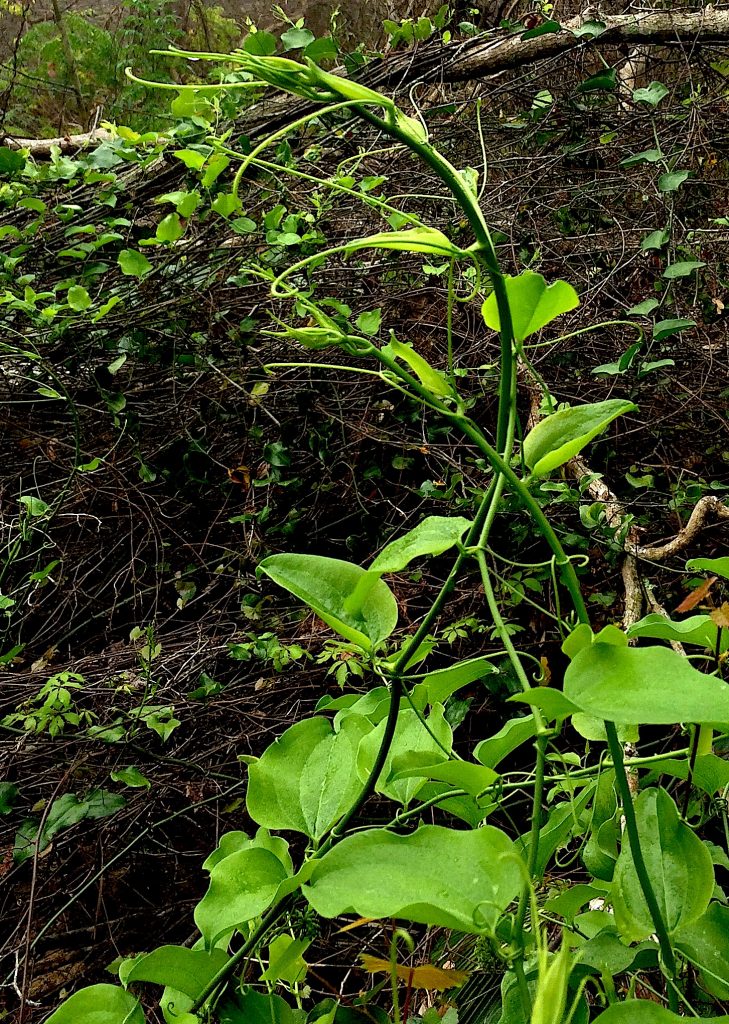
Smilax growing along a bike trail, a good place to find them. Photo by Green Deane
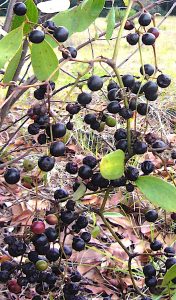
Smilax berries are almost tasty when they look like raisins.
In springtime it is said man’s fancy turns to love. My mine turns to Smilax (which might explain my eternal — or perhaps better called — infernal bachelorhood.) Some folks, however, consider Smilax the best springtime green. While one can find Smilax most of the year it is best locally in spring. As the weather turns hot the edible tips can take on a bitterness (which cooking can remove.) But if you like to eat them raw, now and for the next couple of months, is the best time. Its shriveled black berries are also edible but can range from palatable to not. I avoid the few species that have red berries except for one that grows on Crete. I know those are edible. Smilax incidentally figured in Greek mythology. The Greeks also believed having a baby touch Smilax made it immune to certain poisons. And there is a love story attached to plant. You can read about it and Smilax here.
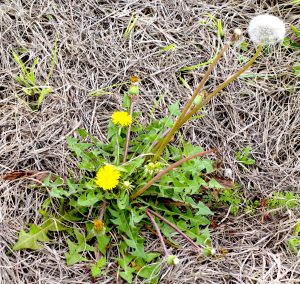
Dandelions are a little difficult to find locally.
We have been seeing some honest-to-goodness Dandelions in recent foraging classes though they are a far cry from their early summer form up north. Dandelions like temperate weather and acidic soil, perfect growing conditions for them such as in New England where the soil is glacial and very acidic. And summer in temperate Maine is also lovely, both days of it… There the Dandelions are huge and prolific. The first wine I made — when about a freshman in high school — was Dandelion Wine. Dandelions don’t like Florida. Florida is a hot, limestone plate, not the best growing conditions for Dandelions, or asparagus or horseradish. So this time of year look for Dandelions near oaks and pines. Fortunately even when stressed most flowers manage to put on a typical blossom and so it is with Dandelions. If it looks like a Dandelion it probably is even if a little smaller. You can read about them and how to make wine here.
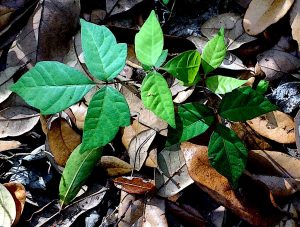
Avoid Poison Ivy which is also sprouting.
Seasonally there are a lot of straddles now. Chickweeds is making its way north, some older plants mid-state, doing well still in northern areas. Poorman’s Peppergrass, Shepherd’s Purse and Western Tansy Mustard are at their seasonal height or approaching it. Hairy Bittercress, another local mustard, is at its seasonal peak as well. Swinecress is seeding and nearly done. And along many dry roads banks now you can see Wild Mustards and Radishes forming low yellow-blossom hedgerows. Native Plantagos are starting to seed signaling an end to their season. Early Sow Thistles are reaching maturity but are still starting seedlings. And I should mention Poison Ivy has started it annual growth as has deadly Water Hemlock.
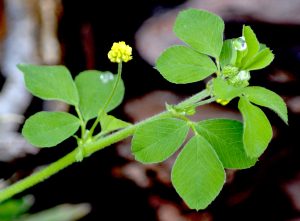
Black Medic and Hop Clover look similar.
A fairly common “What is it?” seen now is Black Medic. It is also an iffy edible. While the seeds and greens have been eaten it’s not for everyone. Also to the every-day forager it looks a lot like Hop Clover. Native to the area of Iran it came to the east coast of the United States around 1807 and went west over the next 130 years. It was on the west coast in time for the Great Depression in the 1930’s. Before they seed the easiest way to identity BlackMedic from Hop CLover is look at the center leaf of the trifolium. Black Medic’s central leaf has a longer stem than the other two leaves. In Hop Clover all three stems are the same length. Also when they seed Black Medic has black seeds, Hop Clover has brown seeds. And locally Black Medic is common whereas Hop Clover is mostly Florida’s northwestern counties. You can read all about it here.

Classes are held rain or shine or cold.
Foraging Classes: You will note I have no classes this last weekend in February because I am attending the seventh Florida Herbal Conference. There are, however, two things to notice in the foraging class lineup for March. The bridge at Haulover Canal has reopened so we will have a class there Sunday March 10th. This is always conditional in that the federal agency in charge can close the bridge at any time for any reason. Also the class at Eagle Park Lake in Largo on the Fourth of March is getting large. If more people sign up I will probably add a second class there on March 3rd.
Sunday, March 4th, Eagle Park Lake, 1800 Keene Road, Largo, FL 33771. 9 a.m. Meet at the pavilion by the dog park.
Saturday, March 10th, Haulover Canal, Merritt Island National Refuge, north of the Kennedy Space Center. 9 a.m. If northbound go over the bridge, take next left, a dirt road, at the canal turn right, go to end. Park anywhere. If southbound a quarter of a mile before the bridge turn right onto dirt road, turn right at the canal, go to end. There is no drinking water, and the bathrooms are one Port-O-Let. It is hot, dry and dusty and we walk about three miles.
Sunday, March 11th, Bayshore Live Oak Park, Bayshore Drive, Port Charlotte. 9 a.m. Meet at the parking lot on Bayshore Drive across from Ganyard Street.
Saturday, March 17th, Blanchard Park, 10501 Jay Blanchard Trail, Orlando, FL 32817. 9 a.m. Meet at the Pavilion east of the tennis courts near the YMCA.
Sunday, March 18th, Dreher Park, 1200 Southern Blvd., West Palm Beach, 33405, 9 a.m. Meet just north of the Science Center in the northern half of the park.
Saturday, March 24th, Florida State College, south campus, 11901 Beach Blvd., Jacksonville, 32246. 9 a.m.We will meet at building “D” next to the administration parking lot.
To read more about the classes or to pre-pay go here.
 Donations to upgrade EatTheWeeds.com are going very well with over $3,600 raised so far. Thank you to all who have contributed to either via the Go Fund Me link or by the PayPal donation link. The fund has been paying down the cost of upgrades started in September with more still needed. (The site has to be moved to a new server — one that can do back ups — and for some reason the ARCHIVE page hates to update. It is a list of everything on site. ETWs itself has been up for over a decade originally on a MAC server. The WordPress operating system was older than that and was barely working well so it needed a major overhaul. I put it off as long as I could. The site’s content itself took many years to create and contains original information on over a thousand of edible plants. It has 145 related videos which are currently on You Tube. Hopefully they can be moved back to the site. The Forum has over 12,000 posts with plans to expand. The goal is to upgrade more, do more videos and get a book published. Finding an index program seems to be a challenge. I also want to get the site in shape so I can will it to some organization when I’m pushing up daisies. You can go to the Go Fund Me page here, or, if you want to use PayPal instead you can use this link.
Donations to upgrade EatTheWeeds.com are going very well with over $3,600 raised so far. Thank you to all who have contributed to either via the Go Fund Me link or by the PayPal donation link. The fund has been paying down the cost of upgrades started in September with more still needed. (The site has to be moved to a new server — one that can do back ups — and for some reason the ARCHIVE page hates to update. It is a list of everything on site. ETWs itself has been up for over a decade originally on a MAC server. The WordPress operating system was older than that and was barely working well so it needed a major overhaul. I put it off as long as I could. The site’s content itself took many years to create and contains original information on over a thousand of edible plants. It has 145 related videos which are currently on You Tube. Hopefully they can be moved back to the site. The Forum has over 12,000 posts with plans to expand. The goal is to upgrade more, do more videos and get a book published. Finding an index program seems to be a challenge. I also want to get the site in shape so I can will it to some organization when I’m pushing up daisies. You can go to the Go Fund Me page here, or, if you want to use PayPal instead you can use this link.

Green Deane DVD Set
All of Green Deane’s videos available for free on You Tube. They do have ads on them so every time you watch a Green Deane video I get a quarter of one cent. Four views, one cent. Not exactly a large money-maker but it helps pays for this newsletter. If you want to see the videos without ads and some in slightly better quality you can order the DVD set. It is nine DVDs with 15 videos on each for a total of 135 videos. Many people want their own copy of the videos or they have a slow service and its easier to order then to watch them on-line. The DVDs make a good gift for that forager you know especially on long, cold winter months. Individual DVDs can also be ordered or you can pick and choose. You can order them by clicking on the button on the top right hand side of this page (if your window is open wide enough.) Or you can go here.
![]() Want to identify a plant? Looking for a foraging reference? Do you have a UFO, an Unidentified Flowering Object you want identified? On the Green Deane Forum we chat about foraging all year. And it’s not just about warm-weather plants or just North American flora. Many nations around the world share common weeds so there’s a lot to talk about. There’s also more than weeds. The reference section has information for foraging around the world. There are also articles on food preservation, and forgotten skills from making bows to fermenting food. One special section is “From the Frightening Mail Bag” where we learn from people who eat first then ask questions later. Recent topics include: Cleavers, Five-Petal Yellow Vine, That’s Poor Man’s Pepper, Coconut Purslane Salad, Green Leaves Inner Purple Outline, New Foraging Seasons, Plant’s In Obama’s Portrait, American Nightshade, and What Plant is this? You can join the forum by clicking on “forum” in the menu.
Want to identify a plant? Looking for a foraging reference? Do you have a UFO, an Unidentified Flowering Object you want identified? On the Green Deane Forum we chat about foraging all year. And it’s not just about warm-weather plants or just North American flora. Many nations around the world share common weeds so there’s a lot to talk about. There’s also more than weeds. The reference section has information for foraging around the world. There are also articles on food preservation, and forgotten skills from making bows to fermenting food. One special section is “From the Frightening Mail Bag” where we learn from people who eat first then ask questions later. Recent topics include: Cleavers, Five-Petal Yellow Vine, That’s Poor Man’s Pepper, Coconut Purslane Salad, Green Leaves Inner Purple Outline, New Foraging Seasons, Plant’s In Obama’s Portrait, American Nightshade, and What Plant is this? You can join the forum by clicking on “forum” in the menu.
This is weekly issue 292.
If you would like to donate to Eat The Weeds please click here.

